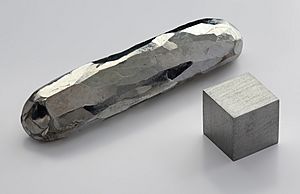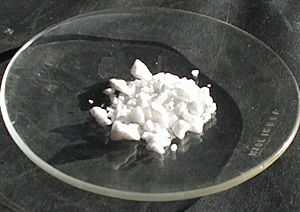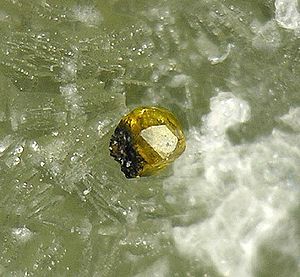Cadmium facts for kids
 |
||||||||||||||||||||||||||||||||||||||||||||||||||||||||||||||||||||
| Cadmium | ||||||||||||||||||||||||||||||||||||||||||||||||||||||||||||||||||||
|---|---|---|---|---|---|---|---|---|---|---|---|---|---|---|---|---|---|---|---|---|---|---|---|---|---|---|---|---|---|---|---|---|---|---|---|---|---|---|---|---|---|---|---|---|---|---|---|---|---|---|---|---|---|---|---|---|---|---|---|---|---|---|---|---|---|---|---|---|
| Pronunciation | /ˈkædmiəm/ |
|||||||||||||||||||||||||||||||||||||||||||||||||||||||||||||||||||
| Appearance | silvery bluish-gray metallic | |||||||||||||||||||||||||||||||||||||||||||||||||||||||||||||||||||
| Standard atomic weight Ar, std(Cd) | 112.414(4) | |||||||||||||||||||||||||||||||||||||||||||||||||||||||||||||||||||
| Cadmium in the periodic table | ||||||||||||||||||||||||||||||||||||||||||||||||||||||||||||||||||||
|
||||||||||||||||||||||||||||||||||||||||||||||||||||||||||||||||||||
| Atomic number (Z) | 48 | |||||||||||||||||||||||||||||||||||||||||||||||||||||||||||||||||||
| Group | group 12 | |||||||||||||||||||||||||||||||||||||||||||||||||||||||||||||||||||
| Period | period 5 | |||||||||||||||||||||||||||||||||||||||||||||||||||||||||||||||||||
| Block | d | |||||||||||||||||||||||||||||||||||||||||||||||||||||||||||||||||||
| Electron configuration | [Kr] 4d10 5s2 | |||||||||||||||||||||||||||||||||||||||||||||||||||||||||||||||||||
| Electrons per shell | 2, 8, 18, 18, 2 | |||||||||||||||||||||||||||||||||||||||||||||||||||||||||||||||||||
| Physical properties | ||||||||||||||||||||||||||||||||||||||||||||||||||||||||||||||||||||
| Phase at STP | solid | |||||||||||||||||||||||||||||||||||||||||||||||||||||||||||||||||||
| Melting point | 594.22 K (321.07 °C, 609.93 °F) | |||||||||||||||||||||||||||||||||||||||||||||||||||||||||||||||||||
| Boiling point | 1040 K (767 °C, 1413 °F) | |||||||||||||||||||||||||||||||||||||||||||||||||||||||||||||||||||
| Density (near r.t.) | 8.65 g/cm3 | |||||||||||||||||||||||||||||||||||||||||||||||||||||||||||||||||||
| when liquid (at m.p.) | 7.996 g/cm3 | |||||||||||||||||||||||||||||||||||||||||||||||||||||||||||||||||||
| Heat of fusion | 6.21 kJ/mol | |||||||||||||||||||||||||||||||||||||||||||||||||||||||||||||||||||
| Heat of vaporization | 99.87 kJ/mol | |||||||||||||||||||||||||||||||||||||||||||||||||||||||||||||||||||
| Molar heat capacity | 26.020 J/(mol·K) | |||||||||||||||||||||||||||||||||||||||||||||||||||||||||||||||||||
Vapor pressure
|
||||||||||||||||||||||||||||||||||||||||||||||||||||||||||||||||||||
| Atomic properties | ||||||||||||||||||||||||||||||||||||||||||||||||||||||||||||||||||||
| Oxidation states | −2, +1, +2 (a mildly basic oxide) | |||||||||||||||||||||||||||||||||||||||||||||||||||||||||||||||||||
| Electronegativity | Pauling scale: 1.69 | |||||||||||||||||||||||||||||||||||||||||||||||||||||||||||||||||||
| Ionization energies |
|
|||||||||||||||||||||||||||||||||||||||||||||||||||||||||||||||||||
| Atomic radius | empirical: 151 pm | |||||||||||||||||||||||||||||||||||||||||||||||||||||||||||||||||||
| Covalent radius | 144±9 pm | |||||||||||||||||||||||||||||||||||||||||||||||||||||||||||||||||||
| Van der Waals radius | 158 pm | |||||||||||||||||||||||||||||||||||||||||||||||||||||||||||||||||||
| Spectral lines of cadmium | ||||||||||||||||||||||||||||||||||||||||||||||||||||||||||||||||||||
| Other properties | ||||||||||||||||||||||||||||||||||||||||||||||||||||||||||||||||||||
| Natural occurrence | primordial | |||||||||||||||||||||||||||||||||||||||||||||||||||||||||||||||||||
| Crystal structure | hexagonal close-packed (hcp) | |||||||||||||||||||||||||||||||||||||||||||||||||||||||||||||||||||
| Speed of sound thin rod | 2310 m/s (at 20 °C) | |||||||||||||||||||||||||||||||||||||||||||||||||||||||||||||||||||
| Thermal expansion | 30.8 µm/(m⋅K) (at 25 °C) | |||||||||||||||||||||||||||||||||||||||||||||||||||||||||||||||||||
| Thermal conductivity | 96.6 W/(m⋅K) | |||||||||||||||||||||||||||||||||||||||||||||||||||||||||||||||||||
| Electrical resistivity | 72.7 nΩ⋅m (at 22 °C) | |||||||||||||||||||||||||||||||||||||||||||||||||||||||||||||||||||
| Magnetic ordering | diamagnetic | |||||||||||||||||||||||||||||||||||||||||||||||||||||||||||||||||||
| Molar magnetic susceptibility | −19.8·10−6 cm3/mol | |||||||||||||||||||||||||||||||||||||||||||||||||||||||||||||||||||
| Young's modulus | 50 GPa | |||||||||||||||||||||||||||||||||||||||||||||||||||||||||||||||||||
| Shear modulus | 19 GPa | |||||||||||||||||||||||||||||||||||||||||||||||||||||||||||||||||||
| Bulk modulus | 42 GPa | |||||||||||||||||||||||||||||||||||||||||||||||||||||||||||||||||||
| Poisson ratio | 0.30 | |||||||||||||||||||||||||||||||||||||||||||||||||||||||||||||||||||
| Mohs hardness | 2.0 | |||||||||||||||||||||||||||||||||||||||||||||||||||||||||||||||||||
| Brinell hardness | 203–220 MPa | |||||||||||||||||||||||||||||||||||||||||||||||||||||||||||||||||||
| CAS Number | 7440-43-9 | |||||||||||||||||||||||||||||||||||||||||||||||||||||||||||||||||||
| History | ||||||||||||||||||||||||||||||||||||||||||||||||||||||||||||||||||||
| Discovery and first isolation | Karl Samuel Leberecht Hermann and Friedrich Stromeyer (1817) | |||||||||||||||||||||||||||||||||||||||||||||||||||||||||||||||||||
| Named by | Friedrich Stromeyer (1817) | |||||||||||||||||||||||||||||||||||||||||||||||||||||||||||||||||||
| Main isotopes of cadmium | ||||||||||||||||||||||||||||||||||||||||||||||||||||||||||||||||||||
|
||||||||||||||||||||||||||||||||||||||||||||||||||||||||||||||||||||
Cadmium is a special kind of metal. It's element number 48 on the periodic table, which is like a big chart of all known elements. Its short symbol is Cd. Cadmium is found in a group on the periodic table called Group 12.
Contents
What is Cadmium Like?
How it Looks and Feels (Physical Properties)
Cadmium is a soft metal that looks blue-gray. You can easily shape it or pull it into wires. This means it is malleable and ductile. It's a bit like zinc, another metal. Cadmium melts at 321 degrees Celsius (610 degrees Fahrenheit).
Cadmium has 8 natural forms called isotopes. Some of these isotopes are slightly radioactive, but most are not very active at all.
How it Reacts (Chemical Properties)
Cadmium is a metal that reacts moderately with other things. If it's in moist air, it can start to rust or corrode. It also dissolves if you put it in acids. If you grind cadmium into a powder and burn it in the air, it turns into a brown powder called cadmium oxide.
Cadmium Compounds
Cadmium can join with other elements to form different chemical compounds. Most of the time, it forms compounds where it has a +2 charge. These compounds often dissolve easily in water. Many of them are white or yellow. For example, cadmium sulfide is a bright yellow color. Cadmium chloride and cadmium sulfate are clear solids that dissolve well in water.
- Cadmium bromide: A pale yellow solid that dissolves in water.
- Cadmium chloride: A clear solid that dissolves in water.
- Cadmium fluoride: A gray solid that does not dissolve well in water.
- Cadmium iodide: A pale yellow solid that dissolves in water.
- Cadmium oxide: Can be white, brown, or red. It dissolves in acids.
- Cadmium sulfate: A clear solid that dissolves in water.
- Cadmium sulfide: A bright yellow solid that does not dissolve in water.
- Cadmium telluride: A black solid used in electronics.
History of Cadmium
Cadmium was first discovered in 1817 by a German chemist named Friedrich Stromeyer. Another chemist, Karl Herman, also found it in 1818. They found it while studying an impurity in zinc carbonate. For about 100 years, most of the world's cadmium came from Germany. In the past, Cadmium iodide was even used as a medicine, even though it was toxic.
Where is Cadmium Found?
Cadmium ores, which are rocks containing the metal, are quite rare. The main ore for cadmium is called Greenockite. This mineral is usually found alongside sphalerite, which is a zinc ore. Because of this, most of the cadmium we use today comes from processing zinc. Pure cadmium metal is very rare to find naturally, but it has been found in one place in Russia.
How is Cadmium Made?
Today, China makes the most cadmium in the world. South Korea and Japan also produce a lot of it. Cadmium is usually separated from zinc. One way is to heat zinc metal in a special container without air. Cadmium boils at a lower temperature than zinc, so it turns into a gas first. This gas is then cooled down to get pure cadmium. Another way is to separate it from the liquid solution used to make pure zinc through a process called electrolysis.
What is Cadmium Used For?
In the 1930s and 1940s, cadmium was mainly used to coat steel. This coating helped stop the steel from rusting. Later, cadmium sulfide was used as a bright yellow pigment in paints.
Today, the biggest use for cadmium is in nickel-cadmium batteries. As of 2009, about 86% of all cadmium was used in these batteries. Some people are trying to find other types of batteries because cadmium can be harmful. Cadmium is still used to coat steel to prevent rust, but this is a much smaller use now.
Cadmium is also used in other things like lasers, nuclear reactors, and special materials called phosphors that glow. It's also found in semiconductors, which are important parts of electronics. A special alloy (a mix of metals) called Wood's metal contains cadmium and melts very easily. Cadmium is also used in some types of solder, which is used to join metal parts.
Interestingly, while cadmium is not used by humans or most animals, a tiny ocean plant called a diatom actually uses cadmium.
Is Cadmium Safe?
Cadmium is a metal that can be very harmful. Breathing in dust from cadmium or its compounds can be dangerous. Because of its risks, some countries have banned cadmium from being used in electronics.
One of the main ways people are exposed to cadmium is through Cigarette smoking. People who smoke usually have about four times more cadmium in their blood than people who don't smoke. Scientists are still studying if cadmium directly causes cancer, or if other things found with it, like arsenic, are the cause.
| Periodic table | |||||||||||||||||||||||||||||||||||||||||
|---|---|---|---|---|---|---|---|---|---|---|---|---|---|---|---|---|---|---|---|---|---|---|---|---|---|---|---|---|---|---|---|---|---|---|---|---|---|---|---|---|---|
| H | He | ||||||||||||||||||||||||||||||||||||||||
| Li | Be | B | C | N | O | F | Ne | ||||||||||||||||||||||||||||||||||
| Na | Mg | Al | Si | P | S | Cl | Ar | ||||||||||||||||||||||||||||||||||
| K | Ca | Sc | Ti | V | Cr | Mn | Fe | Co | Ni | Cu | Zn | Ga | Ge | As | Se | Br | Kr | ||||||||||||||||||||||||
| Rb | Sr | Y | Zr | Nb | Mo | Tc | Ru | Rh | Pd | Ag | Cd | In | Sn | Sb | Te | I | Xe | ||||||||||||||||||||||||
| Cs | Ba | La | Ce | Pr | Nd | Pm | Sm | Eu | Gd | Tb | Dy | Ho | Er | Tm | Yb | Lu | Hf | Ta | W | Re | Os | Ir | Pt | Au | Hg | Tl | Pb | Bi | Po | At | Rn | ||||||||||
| Fr | Ra | Ac | Th | Pa | U | Np | Pu | Am | Cm | Bk | Cf | Es | Fm | Md | No | Lr | Rf | Db | Sg | Bh | Hs | Mt | Ds | Rg | Cn | Uut | Fl | Uup | Lv | Uus | Uuo | ||||||||||
|
|||||||||||||||||||||||||||||||||||||||||
Images for kids
-
Violet light from a helium cadmium metal vapor laser. The highly monochromatic color arises from the 441.563 nm transition line of cadmium.
-
Jinzū River area, which was contaminated with cadmium
See also
 In Spanish: Cadmio para niños
In Spanish: Cadmio para niños
















